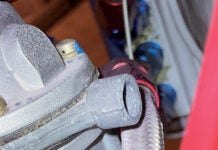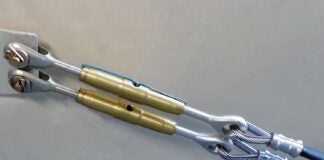The next aviation revolution is coming: electric-powered recreational aircraft. An airshow-center flight of Randall Fishmans ElectraFlyer-C at last summers AirVenture/Oshkosh convention clearly hinted at an enticing future-practical flight powered by electricity costing 50 cents for an hour in the air.
For many thousands of hobby fliers, Fishmans success is not startling. We modelers have flown powerful, high-tech motor-propelled RC model aircraft for more than five years. Lightweight lithium-poly battery packs combined with sophisticated electronic speed controls and brushless electric motors allow nearly silent aerobatics including nose-up hovering. We modelers knew that this technology would eventually scale up to include people-carrying aircraft. (But it will be a while before the power-to-weight ratio of full-scale electrics matches whats available now in a 3-pound model.)
The Electric Airplane
In short, ElectraFlyer-C is a modified single-seat Monnett Moni motorglider. It features about $8500 worth of lithium-poly cells, weighing 78 pounds, and a proprietary motor control and 18-horsepower motor, both built by Fishman.
By last summers gathering, the ElectraFlyer-C had flown more than 40 hours. Duration at about 65 mph is approximately 1.5 hours. Battery charging from 117-volt mains takes a few hours and costs about 75 cents. Fishmans web site offers products to assemble an electric-powered trike hang glider, and power system components for the ElectraFlyer-C program are also for sale.
An Electric Flight Forum
Pilot interest in electric flight was apparent at a panel discussion in the forums area at AirVenture. Held in one of the largest forum buildings, this presentation nearly filled the place.
Moderator Craig Willan, an aerospace-engineering consultant, started by noting that the EAA has petitioned the FAA to modify Light Sport Aircraft (LSA) rules to allow electric propulsion (piston engine power is currently specified). Before turning to the six-person panel for comments, Willan observed that, We have the intellect, the drive, the passion, and the fire in the belly to do something that can change the world. We have the ability. Now we have to take the responsibility.
Panelist David Palombo is president of Aveox, which has made brushless motors for years. These motors are really simple physically, having one moving part, he said. They are reliable, lightweight, powerful, vibration-free, and they produce no pollutants. Because these motors weigh very little compared with piston engines, Palombo said, airplanes will be designed specifically to accommodate them. Most of the motors are brushless and rely on permanent magnet fields. Unlike a conventional motor, the coils do not rotate, so there is no need for a commutator or brushes.
A controller pulses current into the fixed coils, resulting in higher efficiency and power, and lower weight compared with a brushed motor. Magnets are getting stronger and cheaper. Because torque is instantaneous with an electric motor, and there is lots of it with a brushless motor-even at low rpm-there is less need for a speed-reduction unit. The result is better reliability and less weight.
Mechanical engineer Pete Buck, representing Sonex Aircraft, concurred that motors are simple, but he says the required electronic controllers can be challenging. Smooth discharge power at the large current flows required is difficult to achieve, and controller components are expensive.
Longtime homebuilt designer and kitmaker John Monnett (Sonex Aircraft founder), emphasized that systems integration is a challenge. Safety is a concern because the battery stores potentially lethal power. (In electric model aircraft, for example, special charging equipment and techniques are necessary to prevent battery fires and explosions.) We may be years away from truly safe, practical systems, Monnett said. The cost of the components, particularly the motor controller, is a major hurdle for a small company trying to get a foothold in this new technology, he noted. At AirVenture 2007, his company introduced a special Sonex airplane intended as a test bed for electric propulsion.
Morton Grosser was next. He is author of Gossamer Odyssey about Paul MacCreadys human-powered planes, and he was a key participant in the successful Solar Challenger record-setting, solar-powered electric airplane project. He said we are experiencing a change in an energy source, which is a prime mover. Every time there has been such a change, he said, it has been followed by a revolution. He listed the 1827 invention of the steamboat as an example that changed things forever.
Grosser hopes to see an integrated combination of airframe, structure and aerodynamics. Thats why I am here, he said. I believe the technology already exists. He noted that Boeing flew the first hydrogen-powered airplane (with fuel cells) in 2008. As it happened, the Boeing manager of the fuel-cell project was in the audience, and he wondered if EAA could take the lead in getting some motor-controller hardware from hybrid cars into light airplanes.
Next, Randall Fishman, president of Electric Airplane Corporation, noted that his single-seat electric trike (powered hang glider) has worked quite well. He concurred with the others that designers must think of the system as a whole, rather than as its individual parts or systems.
A motorglider-type aircraft is one direction. His new ElectraFlyer-C uses 14,000 watts (about 18.5 hp) to take off and fly. At altitude, it needs only about 5000 watts (less than 7 hp). A two-wheel maingear system with rather long legs (replacing the single glider-style wheel) allows use of a longer, more efficient propeller-an increase in diameter from 33 to 45 inches. Did he tweak the original Moni to make it more efficient? Nothing major, he said. A longer wing would make it more efficient but would slow it down. Moderator Willan described Fishman as the Henry Ford of manned electric-powered flight.
Erik Lindbergh, a longtime proponent of record setting as a way to accomplish goals, is a founder of X Prize, which spurred successful civilian space flight, and he has other projects in mind. Issues critical to our time are coming to a head right now, and we are all seeing that, he said. The people on this panel saw it years ago, and they are already working on solutions. Thats huge.
I don’t know anything about electricity, Lindbergh said, but I seem to have inherited a trait from my grandfather: I see problems with things, and I want to make them better. Charles Lindbergh did that his whole life, he noted.
The X Prize was designed to get you and me into space, he said. Yet the idea went through some extremely critical times and almost shut down. SpaceShipOne very nearly did not come to pass. But we shifted peoples perspectives. Futurists like Burt Rutan and like the panel here can figure out solutions to problems, and they did it in a grand fashion. Now X Prize is focusing on leveraging prize money to solve other grand challenges. The automobile energy efficiency prize is an example. Like the Nobel prizes, we will issue retroactive prizes for breakthroughs in fields like medicine and social advancements. I want my son to have the freedom to fly-whether its powered with electricity, hydrogen or rubber bands-and that is what this represents.
Concluding the forum, Willan noted that significant funding is about to be committed to advancing the cause of electric-powered flight, so stay tuned.
Icing on the Cake
At the forums end, the audience saw Randall Fishman receive the EAAs 48th annual Dr. August Raspet Memorial Award for innovation in light aviation. Past recipients include John Thorp and Burt Rutan.
Many at the forum had the following question: When will we see the ElectraFlyer-C fly? Fishman said he had asked the same question without getting approval to demonstrate it at AirVenture. But two days later, Joe Bennis flew Fishmans electron-powered airplane in front of the weekend spectators, making three passes along the crowded flight line. For most, it was a first look at practical, personal electric-powered flight. Its interesting to speculate on the historic significance of this brief glimpse of an attractive future option for recreational pilots.
For more information, visit http://www.electraflyer.com.
Dave Martin served as editor of this magazine for 17 years and began aviation journalism evaluating ultralights in the early 80s. A former CFI (airplanes, gliders, instruments), hes flown more than 160 aircraft types plus 60 ultralights (including a single-seat, no-basket hot air balloon). Now living at a residential airpark in Oregon, he flies his Spacewalker II homebuilt as a Sport Pilot.













